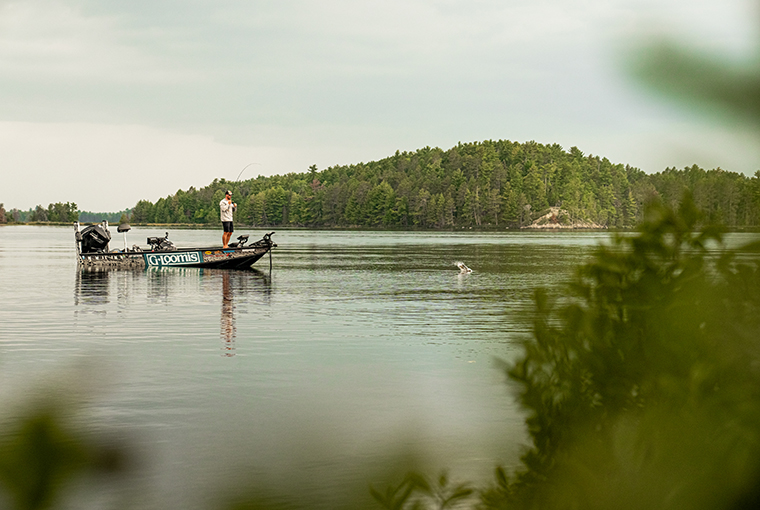
When I was a kid, I kept up my grades in school, but most of my study time was spent poring over fishing magazines. My Grandpa, Wally Stewart, was a big influence. He took me fishing and subscribed to many fishing mags. I still have hundreds from the 70s, 80s, and 90s, including Ontario OUT of DOORS, Angler and Hunter, In-Fisherman, and US-based Fishing Facts.
Those magazines provided my first introduction to Rainy Lake. Growing up in Kenora, I was a couple of hours north of Rainy, so I didn’t get to fish there as a kid. I can remember playing in hockey tournaments in Fort Frances, seeing signs for Rainy Lake, and hoping to fish it one day.
Rainy Lake bass tournament
In 1995, my family learned that the town of Fort Frances was starting a bass tournament. Even though I was only 12, this further piqued my interest. We didn’t sign up for a few years, and I eventually fished in the Fort Frances Canadian Bass Championship, which I haven’t missed in more than 20 years. The event is still going strong and remains a summer highlight, mostly because I love the lake so much.
In addition to bass tournaments, I did a lot of guiding there for Campfire Island Lodge during my university years. At the time, my friend Dean Howard owned the place and let me guide during his busiest weeks. This gave me an opportunity to spend a lot of time on the lake and experience its excellent multispecies fishing. I have many great memories from these trips.
Rainy bays and arms
Rainy offers countless bays and arms, and three unique basins — the north and south arms, and Redgut Bay, each with a variety of opportunities. It is the main feeder of water to Lake of the Woods, via the Rainy River. Several rivers flow into the lake, creating significant current throughout. This current is noticeable in many of the neck-down areas, where the fishing can be really good. Fish are found in predictable locations, behind rocks and corners, where the current pushes food past. On windy days, these areas are often protected and can offer great multispecies fishing.
Lush cabbage beds throughout the lake are always fish magnets in summer, especially dur- ing the warmest stretches. Crayfish are plentiful on the sand and boulder-strewn shorelines and provide a great forage option. Perch, cisco, and smelt are also found in open water.
I grew up on the busy Lake of the Woods, so I appreciate that there is much less activity on Rainy. Sometimes, you might only see another boat or two there. Resorts dot the lake, some offering full American plans, while others are more modest. Unlike many northern waterbodies, Rainy is well charted, making it easy to get around. Many sections of the lake have boat ramps, but many sections are also nowhere near roads, so there’s also plenty of opportunity for adventure.
North arm
The north arm of Rainy, running north to south, is located entirely in Canada and offers the clearest water on the lake. It is well-known for producing above-average pike and walleye and offers excellent smallmouth fishing.
All species spawn in the many shallow bays in the spring and by late June, migrate to main basin areas before setting up on main lake points, humps, and flats. Anglers can fish shallow areas in spring and have great success, but as summer approaches should move to deeper water, in the range of 15 to 25 feet, to keep encountering fish.
Throughout summer, the many cabbage beds that dot the north arm always hold all three species, especially during nice weather. These cabbage fields offer some of the best topwater fishing for smallmouth you will experience.
Some of the most popular areas of the north arm include Northwest Bay, Ash Bay, Woodchuck Island, and Hopkins Bay.
South arm
Known for more tannic water, the south arm of Rainy runs east to west and includes some of the biggest open stretches of water, including Seine Bay. The international border splits the south arm in half between Canada and the US. The southern shoreline is in Minnesota.
Numerous walleye can be found on the many main lake humps during the summer months. While smallmouths and pike numbers may not be as good as in the north arm, the south arm is known for producing some of the largest specimens in the lake. It is unknown why muskie are not plentiful throughout Rainy, but the Seine Bay and river area hosts an excellent muskie population and has produced some of the biggest fish that I have ever heard of from northwestern Ontario.
The far east section of the south arm is remote, without any road access on the Canadian side. Anglers can access this section by boat but some consideration should be given to the weather forecast because big stretches of open water on either side of the Brule Narrows are unforgiving and should be avoided on windy days. Some of the top fishing areas in the south arm include Swell Bay, Seine River, Cormorant Bay, and Brule Narrows.
Redgut Bay
Redgut Bay is located between the north and south arms, entirely in Canada. The area has a variety of water to fish, including deep-water basins and several shallower, fertile bays. It has the most stained water on the lake in some of the shallow bays. This makes for an excellent shallow-water bite for all species throughout the summer.
A few different rivers feed into here, creating some fun places to fish in current. This part of the lake is known to have some of the lake’s best muskie and crappie fishing, as well walleye, pike, and smallmouth.
While I am happy fishing anywhere on Rainy, if I had to pick one area as my favourite, it would be here. It is generally remote, offers great fishing in any weather because you can always find places to hide, and it has some of the most beautiful, natural beaches of anywhere I’ve fished. It’s my happy place.
Over the years fishing the Fort Frances Canadian Bass Championship, I have spent many days fishing the Redgut area and it has been good to me.
Bass championship big draw
Speaking of the championship, it is one of the longest running, most prestigious fishing tournaments in Canada. The three-day event takes place annually in July and draws folks from all over North America. I have made many friends over the years while participating in this tournament and have been fortunate to win it a couple times (2013, 2014) with my long-time friend from Minnesota, John Peterson.
This community-run event has become one of the biggest events in Fort Frances and generates plenty of media attention as a top bass event in North America. It is renowned for the huge crowds that show up for the day-three weigh-ins.
Resorts available
Anglers from across North America visit Rainy Lake every year to experience to top-notch fishing and beautiful scenery. It is not hard to find a nice relaxing place to drop a line along the more than 3,000 kilometres of pine-covered Canadian Shield shoreline.
For visitors, there are many places to stay.
American plan resorts offer full meal plans, house-keeping cabins, and boats with guides. Some outfits offer cabins, where you look after yourself, while others offer options in between. The Sunset Country website offers a full listing of resorts.
Rainy Lake is where I have created some of my fondest on-the-water memories. It is big enough that you can always find new water to explore and remote enough that every outing is an adventure.
Three Rainy Lake resort owners share some tips
Dale Labelle
Labelle’s Birch Point Resort
Favourite spots
Walleye: North arm
Pike: North arm
Smallmouth: Redgut Bay
Top baits
Walleye: Jig and minnow
Pike: Jerkbaits
Smallmouth: Topwater
Resort record
Walleye: 34″, 14 lbs
Pike: 46″, 28 lbs
Smallmouth: 22″, 6 lbs
Matt Goldamer
Sunset Country Outfitters
Favourite spots
Walleye: North arm
Pike: North arm
Smallmouth: South arm
Top baits
Walleye: Smeltinator underspin jig with swimbait
Pike: Chaos Double 8
Smallmouth: Marabou jig
Resort record
Walleye: 31″, 12 lbs
Pike: 45″, 25 lbs
Smallmouth: 22″, 6 lbs
Tom Pearson
Camp Narrows Lodge
Favourite spots
Walleye: North arm
Pike: North arm
Smallmouth: Redgut Bay
Top baits
Walleye: Live bait rigs
Pike: #4 Mepps Spinner
Smallmouth: Soft jerk shad
Resort record
Walleye: 34.5″, 14 lbs
Pike: 44″, 25 lbs
Smallmouth: 23″, 6 lbs
Lake facts
Rainy Lake is shared between Ontario and Minnesota, with approximately 70% of the lake on the Canadian side. It is the fifth largest lake in Ontario outside of the Great Lakes and has nearly 2,200 islands. The outflow of the lake is the Rainy River, the primary source of inflow for Lake of the Woods. There is a famous mermaid statue located just off the main channel, on a small rockpile near Swell Bay.
Sharing the lake
While most of Rainy Lake lies within Ontario, the south side of the lake is located in Minnesota. There are options to fish in US waters, but fishing is better on the Canadian side. Anglers can cross the border for day trips without checking in as long as they don’t touch land, anchor or hover with another boat. Most limits are more conservative for non-resident anglers than they are for residents.
Ice fishing
While Rainy is not as popular as nearby Lake of the Woods for ice fishing, it has excellent options for anglers looking to catch crappie, walleye, or pike. There is always a massive current, so narrow, neck-down areas should be avoided. Most anglers access the ice of Northwest Bay, where all three species are available.
Several areas on Rainy Lake are fish sanctuaries and therefore closed to fishing. Check the latest Fishing Regulations Summary before you go.
Originally published in the June-July issue 2024 of Ontario OUT of DOORS


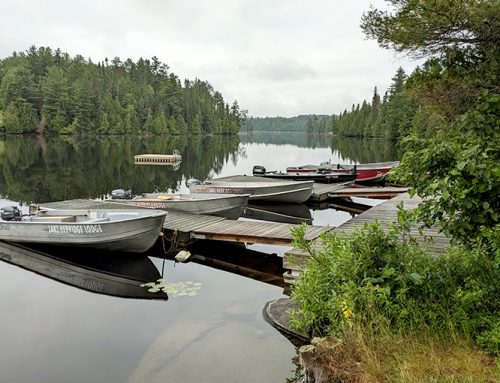
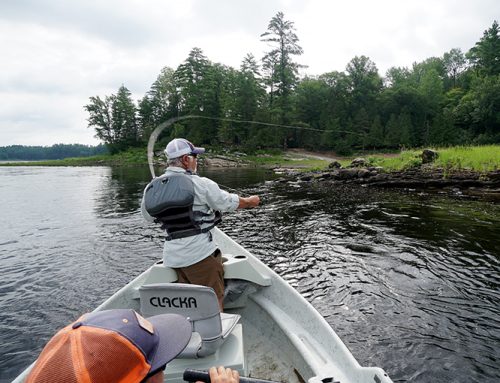
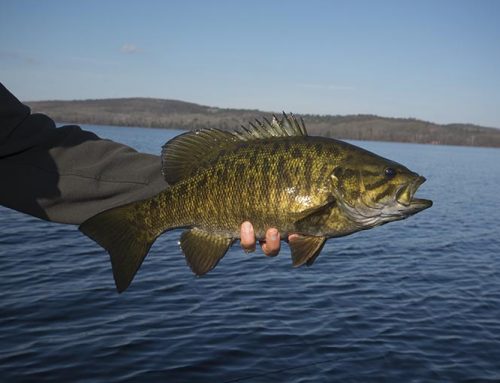
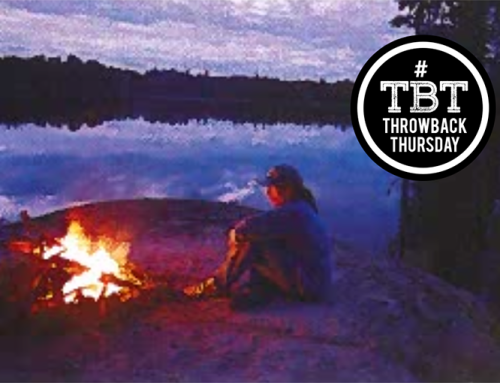
Leave A Comment